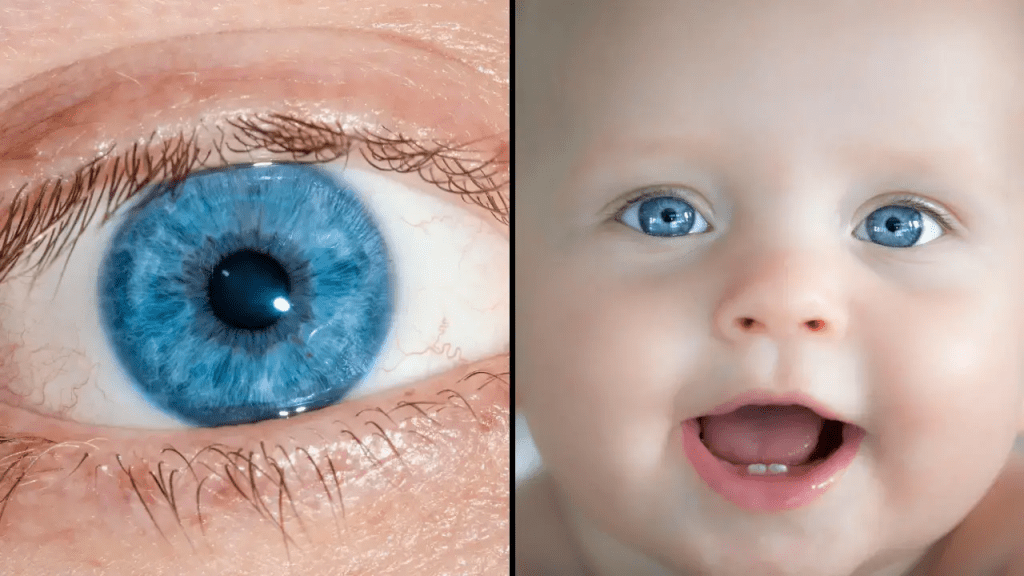Blue eyes have a certain mystique that has captivated people worldwide for centuries. Their piercing, icy hue stands out and draws attention, but few know the remarkable story behind this striking iris color. Believe it or not, blue eyes are the result of a unique genetic mutation that links every blue-eyed person to a common ancestor. Let’s dive into the origin, science, and unique traits associated with blue eyes—a trait found in only a small fraction of the global population.
The Origins of Blue Eyes: A Genetic Mutation

Originally, all humans had brown eyes, thanks to higher levels of melanin in the iris. However, thousands of years ago, a mutation occurred that affected the OCA2 gene, which plays a crucial role in melanin production. This mutation essentially “switched off” the gene responsible for producing brown pigment, leading to the emergence of the first blue-eyed individuals.
This unique mutation likely appeared in a single person in northern Europe, somewhere between 6,000 and 10,000 years ago. From there, this individual’s descendants spread across the continent and beyond, carrying this genetic trait with them. Today, all blue-eyed people can trace their ancestry back to this single ancestor, making blue eyes a genetic marker that connects a small yet distinct portion of humanity.
How Do Blue Eyes Work? The Science Behind the Hue
Blue eyes aren’t actually blue in the sense of containing any blue pigment. Instead, they are the result of a lack of melanin in the front layer of the iris. The structure of the iris scatters light, and as shorter wavelengths reflect back, they produce the appearance of blue. This phenomenon is similar to why the sky looks blue on a sunny day.
In individuals with brown eyes, the higher levels of melanin absorb more light, producing a darker color. Blue eyes, on the other hand, have significantly less melanin, resulting in a lighter hue due to this light-scattering effect. It’s this reduction in melanin that allows for the range of shades we see—from deep, oceanic blues to light, almost translucent blues.
Blue Eyes and Light Sensitivity
Because blue eyes have less melanin than brown or hazel eyes, they offer less protection against harmful UV rays and bright lights. This is why people with blue eyes often experience increased light sensitivity. Less melanin means less filtering of harsh sunlight, which can lead to discomfort and strain in bright environments.
However, this sensitivity is not entirely without its benefits. For example, some studies suggest that people with blue eyes may have an easier time seeing well in dim light. This adaptation could have proven useful for early European inhabitants, who may have needed to rely on sight during long, dark winters.
Unique Characteristics Linked to Blue Eyes
In addition to light sensitivity, blue eyes have been linked to several intriguing traits. Some researchers have noted that people with blue eyes may have a predisposition for strategic thinking. While the evidence is not definitive, it’s interesting to consider that many renowned intellectuals and scientists have had blue eyes, including figures like Stephen Hawking and Marie Curie.
Blue-eyed individuals may also be slightly more likely to be perceived as trustworthy in certain cultural contexts. Studies have suggested that lighter eye colors can sometimes evoke a perception of approachability or innocence, although these perceptions are heavily influenced by social and cultural factors.
The Global Rarity of Blue Eyes
Only about 8-10% of the world’s population has blue eyes, making it a relatively rare trait. This scarcity adds to the allure of blue eyes and explains why they are often considered especially captivating. The distribution of blue eyes is concentrated primarily in Europe, particularly in northern European countries like Sweden, Norway, Denmark, and Estonia, where blue eyes are most prevalent.
In the United States, blue eyes were once common, but their frequency has declined over the past century. Today, they are often celebrated as a rare and beautiful genetic trait, cherished by those who have them and admired by those who don’t.
The Future of Blue Eyes: Will They Become Extinct?
There has been some speculation that blue eyes may eventually become even rarer due to global population trends and increased genetic diversity. However, the odds of them disappearing entirely are low. Although blue eyes result from a recessive gene, meaning that both parents must carry the gene for it to appear in their children, this trait will continue to persist so long as blue-eyed individuals pass it on to future generations.
Genetic diversity is constantly shaping and reshaping human traits, so while the percentage of blue-eyed individuals may continue to shift, it’s likely that this unique characteristic will endure. Blue eyes serve as a testament to the variability within the human genome and the way in which our physical traits are woven into the story of human evolution.
A Shared Heritage: The Blue-Eyed Connection

Perhaps one of the most fascinating aspects of blue eyes is that they create a shared bond among all those who possess them. Every blue-eyed individual, whether they live in Europe, North America, or anywhere else, is connected through a single genetic mutation that occurred thousands of years ago. This common ancestry creates a sense of unity and reminds us that, at a genetic level, we are all more closely related than we might think.
When you meet someone with blue eyes, you’re not just seeing a beautiful color—you’re seeing a reflection of ancient history, an echo of the past that has survived across millennia. In a world that often emphasizes differences, it’s a beautiful reminder of our interconnectedness and the shared heritage that binds us all.
Conclusion: The Allure of Blue Eyes and Their Lasting Impact
Blue eyes may be rare, but their impact on our culture and fascination is undeniable. From their genetic origins to the unique traits associated with them, blue eyes have woven themselves into the fabric of human history. They stand as a reminder of the incredible diversity that exists within our species and the way in which a single, chance mutation can ripple through generations, connecting people across time and space.
So, the next time you find yourself gazing into a pair of blue eyes, remember the remarkable journey that brought them into existence. These eyes are more than just a color—they are a link to a shared past and a symbol of the beautiful, complex genetic tapestry that defines us all.


